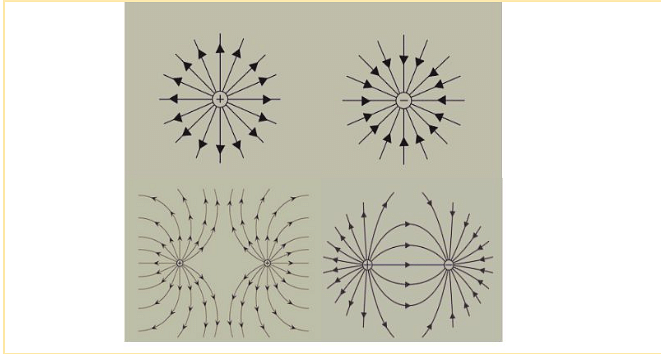This resource provides electrical charges and fields notes to help students understand this topic. The notes cover topics such as electric fields, coulomb’s law, and additivity of charge
An electric charge is an intrinsic property of matter which gives rise to electric force between various objects. There are two charges: positive (+) and negative (-). When there is a loss of an electron, it is coined as a positive charge; when there is a gain in an electron, it is called a negative charge. Likewise, like charges repel each other and unlike charges attract each other.
An electric field is a physical field that surrounds electrically charged particles and acts as an attractor or repellent to all other charged particles in the vicinity.
Important Concept Under Electric Charges and Fields
A charge can neither be created nor destroyed and can only be transferred from one body to another. The total charge of an isolated system remains constant. Let us discuss this in detail the electric charges and fields.
Conductors and Insulators
Any material that permits electricity to flow through it is known as conductors. On the contrary, any material that does not support the free flow of electricity is known as an insulators. Further, conductors possess some electrical charge (electrons) that are comparatively freely moveable.
Besides, when a charge is passed through a conductor, it gets readily distributed over the entire surface of the conductor. However, a charge passes through an insulator and remains in the same place.
Properties of Electric Charge
As we already know, there are two types of charges present, positive and negative. However, their presence tends in a material tends to cancel each other. Now, point charges are determined when the charge size is very small compared to the distance between them. Therefore, all the charges are assumed to be confined to one point in space.
There are three fundamental properties of charge:
Additivity of Charge
According to the definition of additive charges, if there are n number of charges present in a body, the total charge present will be calculated as the algebraic sum of the individual charges.
Conservation of Charge
The conservation of charge defines that the total charge in an electric body never gets altered or changed. The total charge of a body is always conserved, while the amount of positive charge gets deducted from the total negative charge on a point in space.
Quantisation of Charge
The quantisation of charge indicates that any charged particle can possess the charge equal to some integral number of e, i.e., q=n*e
Note: All free charges are experimentally established to be integral multiples of a basic charge, i.e., e.
Coulomb’s Law
Coulomb’s law states that when two charged bodies are present, the force of attraction or the force of repulsion is directly proportional to the product of their magnitude and varied inversely to the square of the distance between them.

Example Ques: The distance between the two electrons in contact is equal to 1Å. Find the Coulomb force that exists between th#conductors-and-insulatorsem.
Solution:
The answer is that an electron has a charge of -1.6 10-19 C, and there is a distance of 1Å between the two charges.
The electrostatic force between the two electrons can be calculated using the following formula: F = k (q2 / r2)
Now, substituting the given values in the above expression as,
F = (9 × 109 Nm2/ C2) [(-1.6 × 10-19 C)2 / (1 Å)2]
= 2.3 × 10−8 N
Forces Between Multiple Charges
When there is more than one charge, columb’s law which is used to determine the mutual electric force between two charges, fails to help.
Superposition of Principles
According to the principle of superposition, it is proved that a force applied on any charge because of several other charges is the vector sum of all the forces on that one charge due to the presence of other charges. However, the individual charges remain unaffected by the presence of any other charge.
Electric Field
Electric Field is described as a property of electric linked with each point in the space where any form of charge is present.
Electric Field Lines
An electric field line is an invisible line or curve drawn from the point of an electric field placed at a tangent that directs the direction of the electric field at that point.
Some of the general properties of electric field lines are:
- Two-line never cross each other
- These electric field lines start on the positive charge and end on the negative charge
- Electrostatic field lines do not form any closed loop

Electric Flux
Electric flux is the total number of electric lines passing through a confined area in the same unit of time. On the contrary, in the case of liquid, there is no physically observable quantity of the similar.
Coming to the practical usuage, Electric flux Δθ through an area element ΔS is defined by
Δθ= E.ΔS= E ΔS cosθ
This is proportional to the number of field lines cutting the area element. The angle θ is the angle between E and ∆S. In a closed surface, where the convention is already stated, θ is the angle between E and the outward normal to the area element. To calculate the total flux through any given surface, divide the surface into small area elements, calculate the flux at each element and add them up. Thus, the total flux θ through a surface S is θ ~ Σ E. ∆S. The approximation symbol is used because the electric field E is taken to be constant over the small area element.

Electric Dipole
The distance between the centres of positive and negative charges and the size of the charge are multiplied together to form the electric dipole moment.
μ=Q×r
Note: Here, r is the distance, and Q is the charge.
Gauss’s Law
According to Gauss's law, the enclosed electric charge directly proportionately affects the net flow of an electric field on a closed surface. The area of the surface in a plane perpendicular to the electric field times the area of the field-passing electric field is how the electric flux is calculated. The net flux of an electric field through a surface, divided by the enclosed charge, should equal a further explanation of Gauss's law.
The class XII syllabus puts a lot of emphasis on electric charges and fields. Electric charges and fields class 12 notes receives about 8 to 10 marks in the exam. Additionally, it is a crucial chapter for NEET. After completing class XII, candidates studying for competitive exams would come across questions from this specific chapter.









